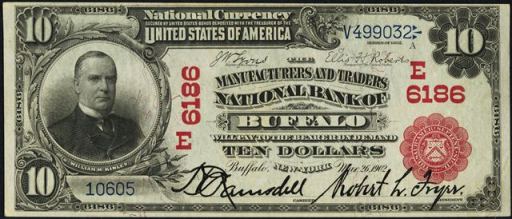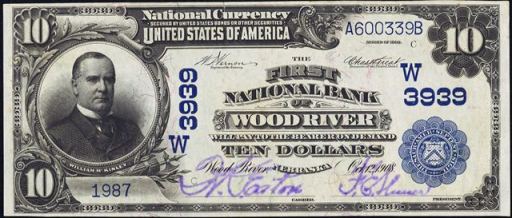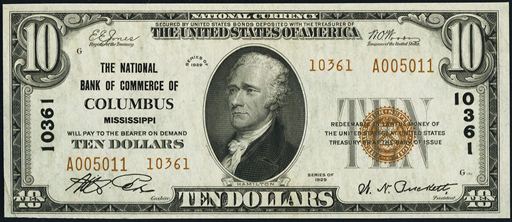The First National Bank Of Lewisburg
The First National Bank Of Lewisburg in Tennessee printed $1,411,760 dollars worth of national currency. Over $1,000,000 face value is a lot of money. However, some types and denominations of currency from this bank could still be rare. This national bank opened in 1907 and stopped printing money in 1935, which equals a 29 year printing period. That is a fairly normal lifespan for a national bank. During its life, The First National Bank Of Lewisburg issued 4 different types and denominations of national currency. We have examples of the types listed below. Your bank note should look similar. Just the bank name will be different. For the record, The First National Bank Of Lewisburg was located in Marshall County. It was assigned charter number 8934.
We buy all national currency. Please call or email us for a quote. Sales@AntiqueMoney.com
The First National Bank Of Lewisburg in Tennessee printed 1,500 sheets of $10 1902 red seal national bank notes. A print range between 1,000 and 2,500 is pretty standard for red seals. Despite being standard, in the scheme of things that is still an extremely small quantity printed. Collectors love ten dollar 1902 red seals. They usually represent the rarest bank notes printed by any national bank. Don’t let the term “series of 1902” confuse you. These were actually printed for about six years between 1902 and 1908. That is obviously a very short issue period which means that many red seals are quite rare. Each note has a portrait of William McKinley. Be sure to check the number under McKinley. If it is #1 then you are dealing with a note from the first sheet of bank notes issued. Number one bank notes are worth even more money than the already rare red seals.
1902 $10 Red Seal National Bank Note
The First National Bank Of Lewisburg printed 25,946 sheets of $10 1902 blue seal national bank notes. Once a bank prints more than 10,000 sheets of blue seals it becomes very difficult for those notes to be rare. 1902 $10 blue seal bank notes all have a portrait of William McKinley on them. Values can range from as little as $40 up to over $10,000. There really is no trick to know what is rare and what is common by just doing an internet search. You really need to work with an expert (like us) in order to determine the value of your specific bank note. There are at least ten different factors than can make some 1902 $10 blue seals worth more than others. We know exactly what to look for and we would be happy to provide a free appraisal and our best offer.
1902 $10 Blue Seal National Bank Note
The First National Bank Of Lewisburg also printed 4,244 individual notes from the type2 1929 $10 national bank note series. That may seem like a high number, but remember that is total notes printed for the denomination, not sheets printed. The easiest way to spot the difference between type1 1929 $10 bills and 1929 type2 $10 bills is in the serial number. Type2 notes have a serial number that ends with a number. 1929 type1 notes have a serial number that ends with the letter A. Generally speaking, these $10 bills are rarer than the earlier type1 issues. However, most collectors don’t pay more for that rarity because they look basically the same.
Series of 1929 Type2 $10 National Bank Note
The First National Bank Of Lewisburg also printed 5,928 individual notes from the type2 1929 $10 national bank note series. This is a pretty typical print run for type2 national bank notes. Values will be across the board based on demand. The easiest way to spot the difference between type1 1929 $10 bills and 1929 type2 $10 bills is in the serial number. Type2 notes have a serial number that ends with a number. 1929 type1 notes have a serial number that ends with the letter A. Generally speaking, these $10 bills are rarer than the earlier type1 issues. However, most collectors don’t pay more for that rarity because they look basically the same.
Series of 1929 Type2 $10 National Bank Note



